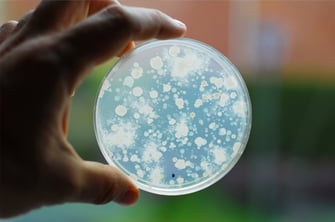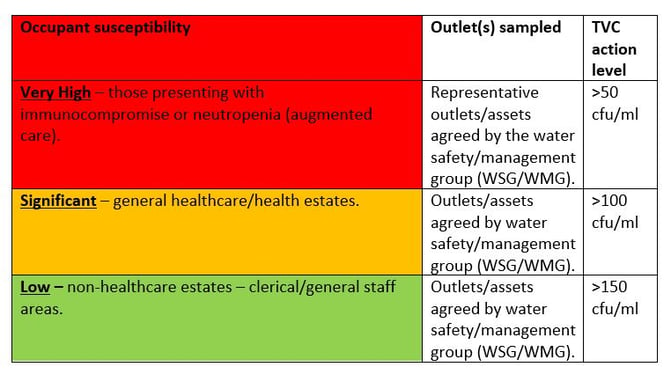To better understand a ‘total viable count’ (TVC), it may be prudent to ask the following questions:
- What is a TVC and why do we sample/test for TVC?
- When do we sample/test for TVC?
- How do we sample/test for TVC?
- What do TVC results mean and what corrective action is required?
What is a TVC and why do we sample/test for TVC?
A TVC test is a ‘total viable count’ which essentially indicates the level of heterotrophic organisms within a sample "an organism deriving its nutritional requirements from complex organic substances". Moreover, heterotrophs are a ‘large group’ of organisms that can be further broken down into the following sub-groups: fungi, yeasts, moulds and bacteria.
Therefore, the results of a TVC test may offer an indication of the ‘general level’ of microbiological contamination within a sampled system. TVC may also be used to assist with identifying microbial contaminants of environmental and or human importance (discussed below in ‘How’ do we sample/test for TVC?).
When do we sample/test for TVC?
When implementing a water management strategy for the safe management of potable water systems, this inevitably will be underpinned by ‘monitoring’, not sampling. Therefore, following associated guidance notes and legislation (ACOP L8, HSG274 and HTM04-01 (healthcare estates) underpinned by the Health and Safety at Work Act 1974 and Health and Social Care Act 2008 (Regulated Activities (Regulations 2015) within health estates), monitoring will be undertaken to ‘establish control’ and sampling will be undertaken for a ‘specific reason’.
Such reasoning may include the identification of taint, taste or odour issues with potable water or following the completion of disinfection works – to help establish the effectiveness of the disinfection process undertaken. However, other (non-potable) waters such as those within endoscopy units and cooling towers will be subject to a different sampling rationale following associated guidance notes and healthcare technical memoranda – to help ensure that these systems (as well as potable water systems) are safely managed whilst undertaking a proportionate approach to water hygiene risk management. Therefore, understanding ‘proportionality’ is key to delivering a ‘sustainable, ‘effective’ and ‘compliant’ water safety strategy of which sampling forms a part.
How do we sample/test for TVC?
 TVC samples should be obtained following guidance in BS 8554 – 2015 sampling from hot and cold water systems, to help ensure that results are representative of the part of the system sampled. Heterotrophic organisms use organic carbon for propagation and proliferation which supports the rationale for the chosen growth media used in the laboratory – ‘yeast extract agar’.
TVC samples should be obtained following guidance in BS 8554 – 2015 sampling from hot and cold water systems, to help ensure that results are representative of the part of the system sampled. Heterotrophic organisms use organic carbon for propagation and proliferation which supports the rationale for the chosen growth media used in the laboratory – ‘yeast extract agar’.
Due to the diverse number of organisms that can be cultured on this type of growth media within the test laboratory, these tests are referred to as non-selective – unlike those used for the culture and enumeration of specific pathogenic bacteria such as Pseudomonas aeruginosa and Legionella which require the use of ‘selective media’ and methodologies that support the growth of the ‘target organism’ and discourage the growth of ‘non-target organisms’.
TVC samples are also incubated at different temperatures depending on the environment sampled, for example it’s indicated to incubate samples from potable water systems at 22°C or 37°C whereas the prescribed method for incubating samples from washer disinfector final rinse waters is 30°C (following the requirements of HTM 01-06).
30°C is also the prescribed temperature for samples taken from cooling tower systems (following ACOP L8, HSG274 Part 1). Therefore, 30°C is accepted as the temperature which best represents ‘favoured growth conditions’ within these risk systems. The reasoning behind incubating potable water samples at 22°C and 37˚C respectively is to delineate between what may be considered environmental contamination and microbiological contaminants of human importance, we know that the optimal growth temperature for waterborne pathogens such as Legionella pneumophila is 37°C.
What do TVC results mean and what corrective action is required?
 Whilst research suggests that TVC test results do not always correlate well with results from tests undertaken to select for contaminants of ‘human importance’, they may provide a broad indication of water system safety – considering that such tests are indicated following the identification of taint, taste or odour issues with water, which in turn may be associated with microbial contamination (release of secondary metabolites from fungal contaminants). So, the questions remain; at what point would it be considered prudent to take corrective action against TVC results (TVC action level) and what corrective action may be taken – considering the requirement to manage water risk with proportionality?
Whilst research suggests that TVC test results do not always correlate well with results from tests undertaken to select for contaminants of ‘human importance’, they may provide a broad indication of water system safety – considering that such tests are indicated following the identification of taint, taste or odour issues with water, which in turn may be associated with microbial contamination (release of secondary metabolites from fungal contaminants). So, the questions remain; at what point would it be considered prudent to take corrective action against TVC results (TVC action level) and what corrective action may be taken – considering the requirement to manage water risk with proportionality?
The table below helps to identify a suitable ‘action level’ for TVC – underpinned by occupant susceptibility:

This table is an example of suggested action levels (as agreed by your Water Safety Group) as definitive action levels are not defined within current guidance.
Further reading> Why am I still getting TVCs after disinfecting and flushing?
Feel free to reach out if you have any questions about the issues mentioned above or if you would like to consult with one of our experts on water hygiene.
Editors Note: The information provided in this blog is correct at the date of original publication - March 2021 (Revised November 2023)
© Water Hygiene Centre 2023








